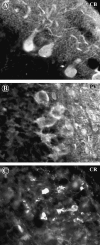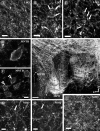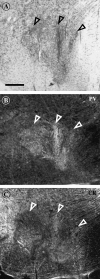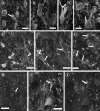Characterization of the rhesus monkey superior olivary complex by calcium binding proteins and synaptophysin
- PMID: 16367802
- PMCID: PMC1571589
- DOI: 10.1111/j.1469-7580.2005.00491.x
Characterization of the rhesus monkey superior olivary complex by calcium binding proteins and synaptophysin
Abstract
This study was performed in order to characterize the main nuclei of the rhesus monkey superior olivary complex by means of antibodies against the calcium binding proteins parvalbumin, calbindin and calretinin and the synaptic vesicle protein synaptophysin. These markers revealed the neuronal morphology and organization of nuclei located within the rhesus monkey superior olivary complex. The architectural details included the distribution of axonal terminals on neurons. The medial superior olivary nucleus was present as a column of neurons. No clear segregation of calretinin-positive terminals was noticed on the medial and lateral dendritic fields of these neurons. The lateral superior olivary nucleus was characterized by a distinct nuclear shape. Calretinin-, parvalbumin- or calbindin-positive terminals contacted somata and dendrites. The medial nucleus of trapezoid body could be clearly differentiated as a distinct region in the rhesus monkey superior olivary complex. Somata of that nucleus showed calbindin- and parvalbumin-labelling whereas somatic calyces of Held were reavealed by calretinin and synaptophysin labelling. The results are discussed with respect to the processing of acoustic information in primate species and their ability to hear high and low frequencies, which is reflected by anatomical correlates.
Figures






Similar articles
-
Characterization of the human superior olivary complex by calcium binding proteins and neurofilament H (SMI-32).J Comp Neurol. 2003 Feb 10;456(3):292-303. doi: 10.1002/cne.10526. J Comp Neurol. 2003. PMID: 12528193
-
Characterization of human auditory brainstem circuits by calcium-binding protein immunohistochemistry.Neuroscience. 2014 Jan 31;258:318-31. doi: 10.1016/j.neuroscience.2013.11.035. Epub 2013 Nov 27. Neuroscience. 2014. PMID: 24291726
-
Parvalbumin, calbindin D-28k, and calretinin immunoreactivity in the ascending auditory pathway of horseshoe bats.J Comp Neurol. 1994 Mar 22;341(4):534-58. doi: 10.1002/cne.903410409. J Comp Neurol. 1994. PMID: 8201027
-
Organization of the human superior olivary complex.Microsc Res Tech. 2000 Nov 15;51(4):403-12. doi: 10.1002/1097-0029(20001115)51:4<403::AID-JEMT8>3.0.CO;2-Q. Microsc Res Tech. 2000. PMID: 11071722 Review.
-
Ascending efferent projections of the superior olivary complex.Microsc Res Tech. 2000 Nov 15;51(4):355-63. doi: 10.1002/1097-0029(20001115)51:4<355::AID-JEMT5>3.0.CO;2-J. Microsc Res Tech. 2000. PMID: 11071719 Review.
Cited by
-
VGLUT1 and VGLUT2 mRNA expression in the primate auditory pathway.Hear Res. 2011 Apr;274(1-2):129-41. doi: 10.1016/j.heares.2010.11.001. Epub 2010 Nov 24. Hear Res. 2011. PMID: 21111036 Free PMC article. Review.
-
Superior olivary complex organization and cytoarchitecture may be correlated with function and catarrhine primate phylogeny.Brain Struct Funct. 2009 Sep;213(4-5):489-97. doi: 10.1007/s00429-008-0201-5. Epub 2009 Jan 31. Brain Struct Funct. 2009. PMID: 19184100 Free PMC article.
-
Characterization of neuronal subsets surrounded by perineuronal nets in the rhesus auditory brainstem.J Anat. 2007 May;210(5):507-17. doi: 10.1111/j.1469-7580.2007.00713.x. J Anat. 2007. PMID: 17451528 Free PMC article.
-
Octopus Cells in the Posteroventral Cochlear Nucleus Provide the Main Excitatory Input to the Superior Paraolivary Nucleus.Front Neural Circuits. 2017 May 31;11:37. doi: 10.3389/fncir.2017.00037. eCollection 2017. Front Neural Circuits. 2017. PMID: 28620283 Free PMC article.
-
Developmental profiles of the intrinsic properties and synaptic function of auditory neurons in preterm and term baboon neonates.J Neurosci. 2014 Aug 20;34(34):11399-404. doi: 10.1523/JNEUROSCI.4734-13.2014. J Neurosci. 2014. PMID: 25143619 Free PMC article.
References
-
- Adams JC, Mugnaini E. Immunocytochemical evidence for inhibitory and disinhibitory circuits in the superior olive. Hear Res. 1990;49:281–298. - PubMed
-
- Andressen C, Blümcke I, Celio MR. Calcium-binding proteins: selective markers of nerve cells. Cell Tiss Res. 1993;271:181–208. - PubMed
-
- Baimbridge KG, Celio MR, Rogers JH. Calcium binding proteins in the nervous system. Trends Neurosci. 1992;15:303–308. - PubMed
-
- Bazwinsky I, Haertig W, Rübsamen R. Distribution of different calcium binding proteins in the cochlear nucleus and superior olivary complex of gerbils and opossum. Abstract ARO Midwinter Mtg. 1999;22:260.
MeSH terms
Substances
LinkOut - more resources
Full Text Sources

